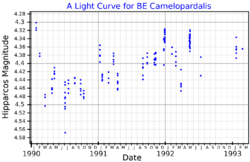Astronomy:BE Camelopardalis
| Observation data Equinox J2000.0]] (ICRS) | |
|---|---|
| Constellation | Camelopardalis |
| Right ascension | 03h 49m 31.27742s[2] |
| Declination | +65° 31′ 33.5567″[2] |
| Apparent magnitude (V) | 4.39[3] (4.35 - 4.48)[4] |
| Characteristics | |
| Evolutionary stage | asymptotic giant branch[5] |
| Spectral type | M2 II[6] |
| B−V color index | 1.870±0.029[3] |
| Variable type | Lc[4] |
| Astrometry | |
| Radial velocity (Rv) | −1.70±1.47[3] km/s |
| Proper motion (μ) | RA: +0.304[2] mas/yr Dec.: −17.482[2] mas/yr |
| Parallax (π) | 4.10 ± 0.46[2] mas |
| Distance | approx. 800 ly (approx. 240 pc) |
| Absolute magnitude (MV) | −2.51[3] |
| Details | |
| Mass | 2.93[7] M☉ |
| Radius | 176[8] R☉ |
| Luminosity | 4,613 - 4,786[8] L☉ |
| Temperature | 3,615±170[8] K |
| Other designations | |
| Database references | |
| SIMBAD | data |
BE Camelopardalis is a solitary[10] variable star in the northern circumpolar constellation of Camelopardalis. It is visible to the naked eye as a faint, red-hued point of light with an apparent visual magnitude that fluctuates around 4.39.[3] The star is located roughly 800 light years away from the Sun based on stellar parallax.[2]
This object is an M-type bright giant with a stellar classification of M2 II,[6] and is currently on the asymptotic giant branch. It is classified as an irregular variable of subtype Lc and its brightness varies from magnitude +4.35 down to +4.48.[4] Having exhausted the supply of hydrogen at its core, the star has expanded to around 176[8] times the Sun's radius. It has 2.9[7] times the Sun's mass and is radiating over four thousand times the luminosity of the Sun from its enlarged photosphere at an effective temperature of 3,615 K.[8]
References
- ↑ "Hipparcos Tools Interactive Data Access". ESA. https://www.cosmos.esa.int/web/hipparcos/interactive-data-access.
- ↑ 2.0 2.1 2.2 2.3 2.4 2.5 Brown, A. G. A. (August 2018). "Gaia Data Release 2: Summary of the contents and survey properties". Astronomy & Astrophysics 616: A1. doi:10.1051/0004-6361/201833051. Bibcode: 2018A&A...616A...1G. Gaia DR2 record for this source at VizieR.
- ↑ 3.0 3.1 3.2 3.3 3.4 Anderson, E.; Francis, Ch. (2012). "XHIP: An extended hipparcos compilation". Astronomy Letters 38 (5): 331. doi:10.1134/S1063773712050015. Bibcode: 2012AstL...38..331A.
- ↑ 4.0 4.1 4.2 Samus, N. N. et al. (2017). "General Catalogue of Variable Stars". Astronomy Reports. 5.1 61 (1): 80–88. doi:10.1134/S1063772917010085. Bibcode: 2017ARep...61...80S.
- ↑ Eggen, Olin J. (July 1992). "Asymptotic giant branch stars near the sun". Astronomical Journal 104 (1): 275–313. doi:10.1086/116239. Bibcode: 1992AJ....104..275E.
- ↑ 6.0 6.1 "The Effective Temperature Scale of Galactic Red Supergiants: Cool, but Not As Cool As We Thought". The Astrophysical Journal 628 (2): 973–985. August 2005. doi:10.1086/430901. Bibcode: 2005ApJ...628..973L.
- ↑ 7.0 7.1 Hohle, M. M. et al. (2010). "Masses and luminosities of O- and B-type stars and red supergiants". Astronomische Nachrichten 331 (4): 349. doi:10.1002/asna.200911355. Bibcode: 2010AN....331..349H.
- ↑ 8.0 8.1 8.2 8.3 8.4 Messineo, M.; Brown, A. G. A. (2019). "A Catalog of Known Galactic K-M Stars of Class I Candidate Red Supergiants in Gaia DR2". The Astronomical Journal 158 (1): 20. doi:10.3847/1538-3881/ab1cbd. Bibcode: 2019AJ....158...20M.
- ↑ "BE Cam". SIMBAD. Centre de données astronomiques de Strasbourg. http://simbad.u-strasbg.fr/simbad/sim-basic?Ident=BE+Cam.
- ↑ Eggleton, P. P.; Tokovinin, A. A. (September 2008). "A catalogue of multiplicity among bright stellar systems". Monthly Notices of the Royal Astronomical Society 389 (2): 869–879. doi:10.1111/j.1365-2966.2008.13596.x. Bibcode: 2008MNRAS.389..869E.
 |


